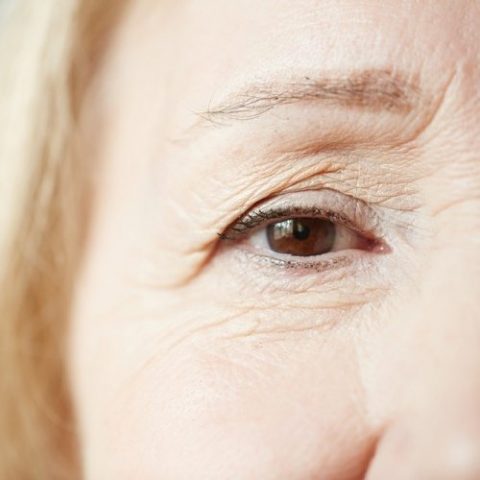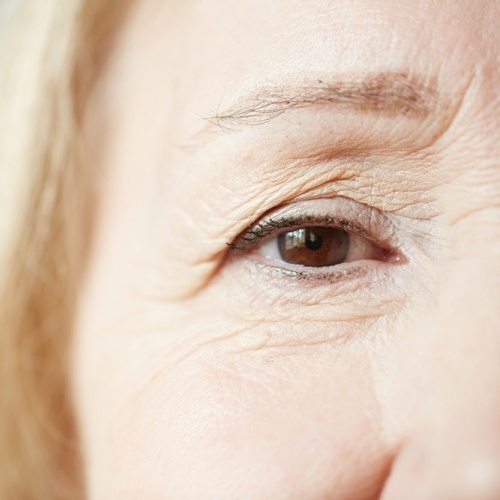
Facelift (Composite Deep Plane)
8 April, 2017
Sad eye of elderly blond-haired woman looking at camera, close-up shot
Eyelid Surgery
If you're considering eyelid surgery...
Eyelid surgery (technically called blepharoplasty) is a procedure to remove fat - usually along with excess skin and muscle from the upper and lower eyelids.
It can correct drooping upper lids and puffy bags below your eyes - features that make you look older and more tired than you feel, and may even interfere with your vision.
Introduction
Aging of the upper and lower eyelids is normally due to a combination of loose skin and protrusion of fat. As this causes the appearance of tiredness and eye bags the operation of eyelid reduction (Blepharoplasty) is one of the commonest procedures for facial rejuvenation. In the upper eyelids ageing causes stretching of the eyelid skin producing a "hooded" appearance. In the lower eyelid the most frequent complaint is of puffiness or eye bags. These problems can be rectified surgically by operating on the eyelid itself and removing or adjusting excess skin and fat (Blepharoplasty).
In some patients, the primary problem may be due to sagging of the eyebrows with age rather than the eyelid in which case a brow lift may be indicated. This can usually be carried using "key hole" techniques leaving few if any scars. The need for brow surgery either alone or in addition to eyelid surgery will be discussed with you at your consultation with Dr. Freschi.

How do I prepare for surgery?
It is important to avoid taking any Aspirin or products containing Aspirin for 2 weeks either side of the operation since Aspirin has an adverse effect on bruising. If you are a smoker it is helpful to stop for two weeks before surgery and for a week afterwards so as not to restrict the circulation to the skin. While making preparations, be sure to arrange for someone to drive you home after your surgery and to help you out for a few days at home.
Where will my surgery be performed?
The surgery is usually performed at a clinic in the city of Buenos Aires where Dr. Freschi works with in Plastic and Aesthetic Surgery. You will usually be admitted on the day of surgery.
You will need a friend or relative to accompany you home when you leave hospital after surgery.
What type of anaesthetic will be used?
Blepharoplasty can be performed under a local or local plus sedation or general anaesthetic, so you'll sleep through the entire operation.
What does the operation involve?
On the upper eyelids the incision is carried out in the natural crease line that is located about 8-10 mm above the eyelashes. Surgery here is designed to correct both the excess skin and the excess fat. After making the incisions, the excess skin and muscle is trimmed from the upper eyelids together with any fat. The incisions are then closed with very fine sutures which are passed below the skin therefore leaving no external stitch marks.
On the lower eyelids, the technique very much depends on the patient's individual circumstance and requirements. If the problem is mainly prominent lower bags without loose skin, you may have what is termed as a transconjuctival blepharoplasty. In this procedure the incision is made inside your lower eyelid, leaving no visible scar. Alternatively, when there is also some loose skin the incision is made just underneath the eyelashes where it is very well hidden. The skin is then lifted upwards and outwards, and after removing some underlying fat, the skin is carefully sutured after removing the excess.
How long will the surgery take?
Blepharoplasty usually takes between an hour or two, depending on the extent of the surgery.
Is it painful?
Your eyelids will probably feel a little tight and as the anaesthetic wears off and it is normal for this to continue for a few days afterwards. Mild painkillers such as paracetamol are usually sufficient to provide comfort. A number of patients may experience a feeling of numbness in the eyelid region. This is normal and usually returns in a matter of weeks, although occasionally it may take a little longer.
What can I expect after the surgery?
It is hoped that you will have only mild swelling and bruising following your Blepharoplasty, however this does vary from patient to patient. Whilst in hospital the nurses may apply cool soothing pads to your eyes in order to minimise this swelling further. In addition it is advised to rest for the first few days with your head elevated on 2-3 pillows as this also helps. .Your eyelids may feel dry at first during the night so eye ointment will be advised to make them more comfortable before sleeping.
During the first week you should avoid straining and bending down as this tends to increase the swelling. After about a week your stitches will be removed by Dr. Freschi and you will be able to wear make-up to hide any residual bruising.
Most patients can return to work after about 7 days although it will probably take at least 3-4 weeks before you would be ready for a major social event. To aid recovery strenuous sport should be avoided for 3-4 weeks. It is better to avoid wearing contact lenses for at least two weeks after Blepharoplasty and in some individuals this is best avoided for about a month.
What are the scars like?
In general, blepharoplasty scars heal well although variations in the healing process do occur from individual to individual. The scars along the lower eyelashes and in the upper lid almost always heal with a near invisible line after several weeks have passed. Those extending out into the crow's feet area can become slightly reddened and may require a little longer to settle completely. Massage of these scars speeds up their recovery and this will be discussed with you by Dr. Freschi once the stitches are out.


